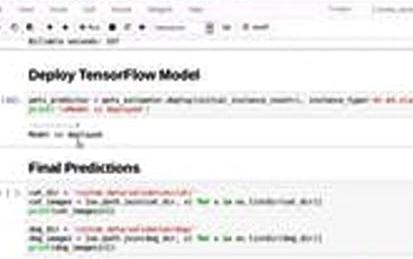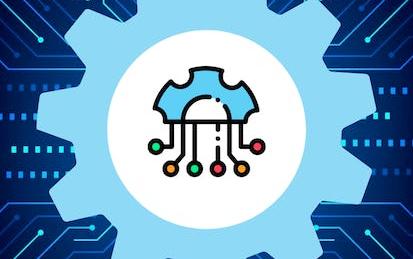

دوراتنا

Support Vector Machine Classification in Python
In this 1-hour long guided project-based course, you will learn how to use Python to implement a Support Vector Machine algorithm for classification. This type of algorithm classifies output data and makes predictions. The output of this model is a set of visualized scattered plots separated with a straight line.
You will learn the fundamental theory and practical illustrations behind Support Vector Machines and learn to fit, examine, and utilize supervised Classification models using SVM to classify data, using Python.
-
Course by

-
 Self Paced
Self Paced
-
 3 ساعات
3 ساعات
-
 الإنجليزية
الإنجليزية

Unsupervised Machine Learning
This course introduces you to one of the main types of Machine Learning: Unsupervised Learning. You will learn how to find insights from data sets that do not have a target or labeled variable. You will learn several clustering and dimension reduction algorithms for unsupervised learning as well as how to select the algorithm that best suits your data.
-
Course by

-
 Self Paced
Self Paced
-
 23 ساعات
23 ساعات
-
 الإنجليزية
الإنجليزية

Supervised Learning and Its Applications in Marketing
Welcome to the Supervised Learning and Its Applications in Marketing course! Supervised learning is the process of making an algorithm to learn to map an input to a particular output. Supervised learning algorithms can help make predictions for new unseen data. In this course, you will use the Python programming language, which is an effective tool for machine learning applications. You will be introduced to the supervised learning techniques: regression and classification. The course will focus on the applications of these techniques in the domain of marketing.
-
Course by

-
 Self Paced
Self Paced
-
 22 ساعات
22 ساعات
-
 الإنجليزية
الإنجليزية

Train Machine Learning Models
This course is designed for business professionals that wish to identify basic concepts that make up machine learning, test model hypothesis using a design of experiments and train, tune and evaluate models using algorithms that solve classification, regression and forecasting, and clustering problems. To be successful in this course a learner should have a background in computing technology, including some aptitude in computer programming.
-
Course by

-
 Self Paced
Self Paced
-
 29 ساعات
29 ساعات
-
 الإنجليزية
الإنجليزية

Using TensorFlow with Amazon Sagemaker
Please note: You will need an AWS account to complete this course. Your AWS account will be charged as per your usage. Please make sure that you are able to access Sagemaker within your AWS account. If your AWS account is new, you may need to ask AWS support for access to certain resources. You should be familiar with python programming, and AWS before starting this hands on project. We use a Sagemaker P type instance in this project, and if you don't have access to this instance type, please contact AWS support and request access.
-
Course by

-
 Self Paced
Self Paced
-
 3 ساعات
3 ساعات
-
 الإنجليزية
الإنجليزية

Basic Recommender Systems
The Basic Recommender Systems course introduces you to the leading approaches in recommender systems. The techniques described touch both collaborative and content-based approaches and include the most important algorithms used to provide recommendations. You'll learn how they work, how to use and how to evaluate them, pointing out benefits and limits of different recommender system alternatives. After completing this course, you'll be able to describe the requirements and objectives of recommender systems based on different application domains.
-
Course by

-
 Self Paced
Self Paced
-
 12 ساعات
12 ساعات
-
 الإنجليزية
الإنجليزية

Tweet Emotion Recognition with TensorFlow
In this 2-hour long guided project, we are going to create a recurrent neural network and train it on a tweet emotion dataset to learn to recognize emotions in tweets. The dataset has thousands of tweets each classified in one of 6 emotions. This is a multi class classification problem in the natural language processing domain. We will be using TensorFlow as our machine learning framework. You will need prior programming experience in Python.
-
Course by

-
 Self Paced
Self Paced
-
 3 ساعات
3 ساعات
-
 الإنجليزية
الإنجليزية

Sort students marks using bubble and insertion algorithms
The learner will create two sorting algorithms in Java programming language. The learner will create an optimised bubble sort function that sorts students' marks in ascending order by repeatedly swapping adjacent elements within an array if they are in the wrong order. The learner will also create an insertion sort function that sorts students' marks in ascending order by building a sorted array, one element at a time.
-
Course by

-
 Self Paced
Self Paced
-
 2 ساعات
2 ساعات
-
 الإنجليزية
الإنجليزية

Music Recommender System Using Pyspark
Nowadays, recommender systems are everywhere. for example, Amazon uses recommender systems to suggest some products that you might be interested in based on the products you've bought earlier. Or Spotify will suggest new tracks based on the songs you use to listen to every day. Most of these recommender systems use some algorithms which are based on Matrix factorization such as NMF( NON NEGATIVE MATRIX FACTORIZATION) or ALS (Alternating Least Square).
-
Course by

-
 Self Paced
Self Paced
-
 2 ساعات
2 ساعات
-
 الإنجليزية
الإنجليزية

AI Workflow: Enterprise Model Deployment
This is the fifth course in the IBM AI Enterprise Workflow Certification specialization. You are STRONGLY encouraged to complete these courses in order as they are not individual independent courses, but part of a workflow where each course builds on the previous ones. This course introduces you to an area that few data scientists are able to experience: Deploying models for use in large enterprises. Apache Spark is a very commonly used framework for running machine learning models. Best practices for using Spark will be covered in this course. Best practices for
-
Course by

-
 Self Paced
Self Paced
-
 9 ساعات
9 ساعات
-
 الإنجليزية
الإنجليزية

Introduction to Computer Vision
Introduction to Computer Vision guides learners through the essential algorithms and methods to help computers 'see' and interpret visual data. You will first learn the core concepts and techniques that have been traditionally used to analyze images. Then, you will learn modern deep learning methods, such as neural networks and specific models designed for image recognition, and how it can be used to perform more complex tasks like object detection and image segmentation.
-
Course by

-
 Self Paced
Self Paced
-
 8 ساعات
8 ساعات
-
 الإنجليزية
الإنجليزية

Introduction to AI in the Data Center
Welcome to the Introduction to AI in the Data Center Course!
As you know, Artificial Intelligence, or AI, is transforming society in many ways.
From speech recognition to improved supply chain management, AI technology provides enterprises with the compute power, tools, and algorithms their teams need to do their life’s work.
But how does AI work in a Data Center? What hardware and software infrastructure are needed?
These are some of the questions that this course will help you address.
-
Course by

-
 Self Paced
Self Paced
-
 5 ساعات
5 ساعات
-
 الإنجليزية
الإنجليزية

System Validation (2): Model process behaviour
System Validation is the field that studies the fundamentals of system communication and information processing. It is the next logical step in computer science and improving software development in general. It allows automated analysis based on behavioural models of a system to see if a system works correctly. We want to guarantee that the systems does exactly what it is supposed to do. The techniques put forward in system validation allow to prove the absence of errors.
-
Course by

-
 Self Paced
Self Paced
-
 5 ساعات
5 ساعات
-
 الإنجليزية
الإنجليزية

Machine Learning Under the Hood: The Technical Tips, Tricks, and Pitfalls
Machine learning. Your team needs it, your boss demands it, and your career loves it. After all, LinkedIn places it as one of the top few "Skills Companies Need Most" and as the very top emerging job in the U.S. If you want to participate in the deployment of machine learning (aka predictive analytics), you've got to learn how it works. Even if you work as a business leader rather than a hands-on practitioner – even if you won't crunch the numbers yourself – you need to grasp the underlying mechanics in order to help navigate the overall project.
-
Course by

-
 Self Paced
Self Paced
-
 17 ساعات
17 ساعات
-
 الإنجليزية
الإنجليزية

Teaching Impacts of Technology: Relationships
In this course you’ll focus on how “smart” devices have changed how we interact with others in personal ways, impacting how we stay connected in our increasingly mobile society. This will be done through a series of paired teaching sections, exploring a specific “Impact of Computing” in your typical day and the “Technologies and Computing Concepts” that enable that impact, all at a K12-appropriate level.
-
Course by

-
 Self Paced
Self Paced
-
 11 ساعات
11 ساعات
-
 الإنجليزية
الإنجليزية

Developing AI Applications on Azure
This course introduces the concepts of Artificial Intelligence and Machine learning. We'll discuss machine learning types and tasks, and machine learning algorithms. You'll explore Python as a popular programming language for machine learning solutions, including using some scientific ecosystem packages which will help you implement machine learning. Next, this course introduces the machine learning tools available in Microsoft Azure. We'll review standardized approaches to data analytics and you'll receive specific guidance on Microsoft's Team Data Science Approach.
-
Course by

-
 Self Paced
Self Paced
-
 16 ساعات
16 ساعات
-
 الإنجليزية
الإنجليزية

Compare Models with Experiments in Azure ML Studio
Did you know that you can compare models in Azure Machine Learning? In this 1-hour project-based course, you will learn how to log plots in experiments, log numeric metrics in experiments and visualize metrics in Azure Machine Learning Studio. To achieve this, we will use one example data, train a couple of machine learning algorithms in Jupyter notebook and visualize their results in Azure Machine Learning Studio Portal interface. In order to be successful in this project, you will need knowledge of Python language and experience with machine learning in Python.
-
Course by

-
 Self Paced
Self Paced
-
 4 ساعات
4 ساعات
-
 الإنجليزية
الإنجليزية

Data Engineering in AWS
Data Engineering in AWS is the first course in the AWS Certified Machine Learning Specialty specialization. This course helps learners to analyze various data gathering techniques. They will also gain insight to handle missing data. This course is divided into two modules and each module is further segmented by Lessons and Video Lectures. This course facilitates learners with approximately 2:30-3:00 Hours Video lectures that provide both Theory and Hands -On knowledge. Also, Graded and Ungraded Quiz are provided with every module in order to test the ability of learners.
-
Course by

-
 Self Paced
Self Paced
-
 4 ساعات
4 ساعات
-
 الإنجليزية
الإنجليزية

Genomic Data Science and Clustering (Bioinformatics V)
How do we infer which genes orchestrate various processes in the cell? How did humans migrate out of Africa and spread around the world?
-
Course by

-
 Self Paced
Self Paced
-
 10 ساعات
10 ساعات
-
 الإنجليزية
الإنجليزية

Predict Ad Clicks Using Logistic Regression and XG-Boost
In this project, we will predict Ads clicks using logistic regression and XG-boost algorithms. In this project, we will assume that you have been hired as a consultant to a start-up that is running a targeted marketing ad campaign on Facebook. The company wants to analyze customer behavior by predicting which customer clicks on the advertisement.
-
Course by

-
 Self Paced
Self Paced
-
 3 ساعات
3 ساعات
-
 الإنجليزية
الإنجليزية

Machine Translation
Welcome to the CLICS-Machine Translation MOOC This MOOC explains the basic principles of machine translation. Machine translation is the task of translating from one natural language to another natural language. Therefore, these algorithms can help people communicate in different languages. Such algorithms are used in common applications, from Google Translate to apps on your mobile device. After taking this course you will be able to understand the main difficulties of translating natural languages and the principles of different machine translation approaches.
-
Course by

-
 Self Paced
Self Paced
-
 28 ساعات
28 ساعات
-
 الإنجليزية
الإنجليزية

Introduction to Machine Learning in Sports Analytics
In this course students will explore supervised machine learning techniques using the python scikit learn (sklearn) toolkit and real-world athletic data to understand both machine learning algorithms and how to predict athletic outcomes.
-
Course by

-
 Self Paced
Self Paced
-
 13 ساعات
13 ساعات
-
 الإنجليزية
الإنجليزية

Parallel programming (Scala 2 version)
With every smartphone and computer now boasting multiple processors, the use of functional ideas to facilitate parallel programming is becoming increasingly widespread. In this course, you'll learn the fundamentals of parallel programming, from task parallelism to data parallelism. In particular, you'll see how many familiar ideas from functional programming map perfectly to to the data parallel paradigm.
-
Course by

-
 Self Paced
Self Paced
-
 33 ساعات
33 ساعات
-
 الإنجليزية
الإنجليزية

Automated Reasoning: Symbolic Model Checking
The Automated Reasoning: Symbolic Model Checking course presents how the properties of acting systems and programs can be verified automatically. The basic notion is a transition system: any system that can be described by states and steps. We present how in CTL (computation tree logic) properties like reach-ability can be described. Typically, a state space may be very large. One way to deal with this is symbolic model checking: a way in which sets of states are represented symbolically.
-
Course by

-
 Self Paced
Self Paced
-
 13 ساعات
13 ساعات
-
 الإنجليزية
الإنجليزية

Methods for Solving Problems
In this course, we will explore different types of problems, the boundaries of what makes a problem solvable, and the different algorithms, rules, and heuristics we can implement to solve these problems.
-
Course by

-
 Self Paced
Self Paced
-
 7 ساعات
7 ساعات
-
 الإنجليزية
الإنجليزية



